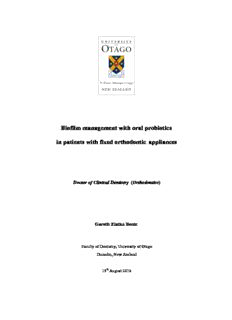
Biofilm management with oral probiotics in patients with fixed orthodontic appliances PDF
Preview Biofilm management with oral probiotics in patients with fixed orthodontic appliances
Biofilm management with oral probiotics in patients with fixed orthodontic appliances Doctor of Clinical Dentistry (Orthodontics) Gareth Zlatko Benic Faculty of Dentistry, University of Otago Dunedin, New Zealand 19th August 2016 Supervisors: Dr. Li Mei Prof. Mauro Farella Dr. Nicholas Heng Prof. Richard Cannon Biofilm management with oral probiotics in patients with fixed orthodontic appliances Copyright © 2016 by Gareth Benic Printed by Uniprint University of Otago, Dunedin, New Zealand Abstract ABSTRACT Introduction: The risk of biofilm formation in orthodontic patients is even higher than the general dental population due to the presence of microniches and increased surface area provided by orthodontic brackets and appliances. If left untreated, oral biofilm can cause white spot lesions, gingivitis and halitosis. Traditional mechanical and chemical methods of managing biofilm formation all have limitations, which warrants the search for novel ways of biofilm management. Probiotics have shown to be beneficial in the oral health of general dental patients. Therefore the aim of this study was to investigate the efficacy of the oral probiotic Streptococcus salivarius M18 in managing biofilm formation in patients wearing fixed orthodontic appliances and to assess its effects on the oral microbiome of these patients. Methods: The study was designed as a prospective, randomised, triple-blind, two-arm parallel-group, placebo-controlled trial. Sixty-four patients undergoing fixed treatment consumed 2 lozenges daily of probiotic (n = 32) or placebo (n = 32). The outcome measures were plaque index (PI), gingival index (GI) and halitosis-causing volatile sulphur compound (VSC) levels. Oral microflora was analysed utilising next-generation sequencing of the bacterial 16S rRNA gene. Results: No significant differences in PI and GI scores were found between probiotic group and placebo-control group (p > 0.05). The level of VSCs significantly decreased in both probiotic group (VSC reduction = -8.5%, p = 0.015) and placebo group (-6.5%, p = 0.039) after 1-month. However, after the 3-month follow-up, VSC levels of the placebo- control group returned to baseline levels whereas those of the probiotic group decreased further compared to baseline readings (-10.8%, p = 0.005). The next-generation sequencing showed that the oral ecology of both groups was similar and that there was a significant increase in the abundance of streptococci in both the probiotic and placebo group over time. Conclusion: Oral probiotic S. salivarius M18 reduced the VSC levels in patients with fixed appliances but did not decrease their plaque or gingival indices. The influence of probiotic S. salivarius M18 on oral microflora seems to be minimal. A longer intervention and follow-up period are needed. Contents Chapter 1 General introduction and aims of this thesis 1 Probiotics and oral health: a review Aims of this thesis Chapter 2 Efficacy of oral probiotic Streptococcus salivarius M18 in 23 enhancing oral hygiene in patients wearing fixed orthodontic appliances – A triple-blind randomised placebo-controlled trial Chapter 3 Oral microbiome changes with use of oral probiotic 45 Streptococcus salivarius M18 in orthodontic patients Chapter 4 General Discussion 83 Summary 91 Appendices 95 Acknowledgements 143 Chapter 1 Probiotics and oral health: a review ABSTRACT Oral biofilms can cause a number of oral diseases such as dental caries, periodontitis, gingivitis, halitosis and candidosis. Mechanical and chemical methods have traditionally been used to remove oral biofilms but they have limitations. Oral probiotics have shown potential in affecting pathogens found in biofilms without impacting negatively on the normal oral microbiota and thus their application in dental patients has garnered much attention. Probiotics come in a number of strains, all of which have similar mechanisms of action exerting their effects on pathogens either directly or indirectly. Their use in dental patients has shown a good proportion of positive effects on caries, periodontitis, gingivitis, candidosis and halitosis. The risk of biofilm formation in orthodontic patients is even higher than the general dental population due to the presence of microniches and increased surface area provided by orthodontic brackets and appliances. For this reason, the effect of probiotics on orthodontic biofilms is gaining a lot of interest. There have only been a handful of studies investigating the effect of probiotics in orthodontic patients, although the effects have been somewhat positive. However, studies to date are difficult to compare and often conducted quite poorly. There are a number of obvious gaps in the current literature that make comparing studies and drawing accurate conclusions on this subject somewhat difficult. Hence this review on probiotics and oral health concludes with suggestions of possible future directions probiotic studies should take when tested in dental populations. By doing this, it is intended that their true relevance in dentistry and orthodontics can be realised. 2
Description: